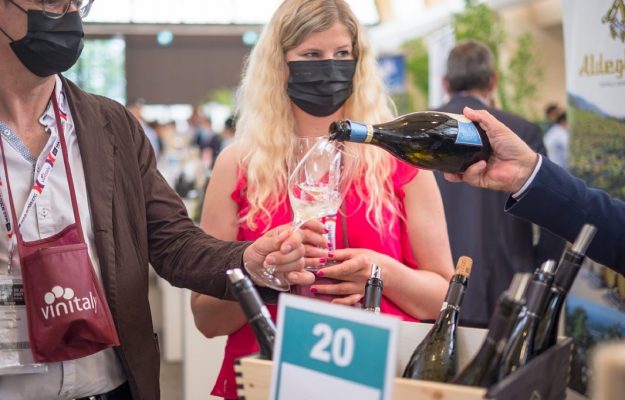Only 5% of bottles of Italian still wine destined for export leave the cellars at more than 9 euros per liter, while 75% do not exceed the 6 euro threshold. A lower position not only compared to competitors such as New Zealand, France and Australia, but also on the world average of trade. A gap, despite progress made in recent years, that can and must change. This was revealed today by “Vinitaly Special Edition” 2021, a study by the newly-created Observatory of UIV-Unione Italiana Vini conducted in collaboration with Vinitaly. Overall, according to the analysis, the popular segment (3-6 euro/liter) is the most popular for Italian wine in the world with almost half of the volumes, followed by basic (up to 3 euro) with 28%, premium (6-9 euro) with 20% and super-premium (over 9 euro).
According to the Observatory, despite a context of general growth in average price and with the due exceptions given in particular by the Tuscan and Piedmontese reds, the world’s second wine power has ample margins for growth. The plastic demonstration of this is given by the positioning, compared to competitors, of the Made in Italy product in the main international outlet markets updated at the end of 2020. In the United States, only 26% of our wines are in the premium (from 6 to 9 euros/liter) or super-premium (from 9 euros and more) bracket: just over half compared to New Zealanders, who add 46% in the high-end segments and even less than France, which dominates with 66% premium or super-premium. But it is not only the world’s leading market - where even Piedmontese reds are at the same level as French Bordeaux - that underestimates Italian quality.
According to the new Observatory presented today, in collaboration with Wine Intelligence and Iwsr, even in China we can do better. In the Dragon, with 21% of products quoted above 6 euros/liter, we are ahead of Spain and Chile, but we are still a long way behind France (38%) and above all Australia (76%). All this, despite the positioning of Tuscan reds, which account for 80% of sales in the premium segment, compared to 78% for Bordeaux wines and 71% for Australians. Among the other large markets, medium-low prices also for orders from the UK and Germany, where 8 out of 10 bottles belong to the basic or popular segments, while in Canada the most sought-after segments are the prerogative of American and French wines. Things are going better in Japan, with Italy second only to France. According to the Observatory’s analysis, it is necessary to build on the cases of high positioning of some Denominations in Piedmont and Tuscany, a model that can be replicated for many other DOC wines that aspire to the premium segment.
“The growth in value in recent years has been more significant than that of other wine-producing countries”, said the secretary general of UIV, Paolo Castelletti, “but we are only halfway through the process and the potential margins are considerable, considering the quality of the product. A change of pace is needed in terms of brand positioning and the identity of our wine; assets that can be achieved through far-sighted sector policies agreed with companies, with a less individualistic approach to promotion, greater homogeneity in the high standing of the major denominations and important identity work linked to new trends, starting with green wines. On this issue, it will be essential to complete the process of defining the public standard on sustainability that will lead to being the first in Europe to have a State logo on products with sustainable certification, following the New Zealand example”. According to the CEO of VeronaFiere, Giovanni Mantovani, “today, as in the best Made in Italy industries, the challenge of Italian wine is played out through analysis, strategies, promotion, identity and on- and off-line relations. The sector is increasingly playing its game of the future on these elements, and Vinitaly wants to be a partner in this challenge, just as it has been in the past. For this reason, we have embraced the new Observatory: introspection on markets is a fundamental aspect for Vinitaly, which increasingly wants to forecast business dynamics, as well as propose strategies and actions to the sector, its organizations and institutions”.
The question of sparkling wines is more complex. Thanks to Prosecco, the value of Italian sparkling wines has almost quadrupled in the last 10 years, exceeding the threshold of 4 million hectolitres in 2020. This is probably a unique case among the Made in Italy sectors, which is now aiming at the challenge of “democratic luxury”. The progressive occupation of the middle range has been great merit of the Italian sparkling wine industry, as it has created a market segment that did not exist before. The challenge for the next few years will be to try to occupy the premium bracket as well, the one between 7 and 10 euros: at world level, in fact, only 13% of sales are in this segment, where most of the “first price” Champagnes are present. Prosecco, which can no longer expect to grow only muscularly, must strive for growth in terms of value, and the Prosecco rosa operation is a step in this direction. A phenomenon that has also acted as a driving force for a typology of Italian sparkling wines that within three years will touch the billion bottle mark, with the growth of indigenous production whose premium option seems the most suitable.
The Observatory presentation also included round table talks by Marchesi Frescobaldi president and UIV vice-president Lamberto Frescobaldi, Terra Moretti CEO Massimo Tuzzi, Kellerei Girlan CEO Oscar Lorandi, Prosecco Doc Consortium president Stefano Zanette and Antinori's head of Solaia and private clients Francesco Visani.
Copyright © 2000/2025
Contatti: info@winenews.it
Seguici anche su Twitter: @WineNewsIt
Seguici anche su Facebook: @winenewsit
Questo articolo è tratto dall'archivio di WineNews - Tutti i diritti riservati - Copyright © 2000/2025








































































































































































































